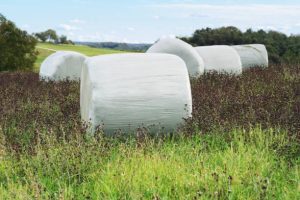Using silage wrap from https://unipak.com.au/silage-wrap/ can have several advantages, including reduced plastic waste and better fermentation and exclusion of oxygen. However, if you are not a large operation, you may be unable to justify purchasing a baler/wrapper.
Less plastic means less waste
Farmers widely use plastic sheeting to protect silage and hay. It can be used as silage bunker top covers, long bags, or even individual hay bale wraps. In Wisconsin, for example, farmers use 15 to 20 pounds of plastic wrap per cow annually. Experts say a typical 300-head dairy farm generates 6,000 pounds of plastic waste yearly.
 However, there are some disadvantages to using plastic in hay baling. First of all, it can be harmful to the environment. Although there are currently no guidelines regarding the disposal of used plastic, producers can recycle used plastic wraps. This method can be helpful in areas where there is a large amount of waste plastic.
However, there are some disadvantages to using plastic in hay baling. First of all, it can be harmful to the environment. Although there are currently no guidelines regarding the disposal of used plastic, producers can recycle used plastic wraps. This method can be helpful in areas where there is a large amount of waste plastic.
Second, bale weights can vary widely. Depending on how many wraps were used, they can be six or eight mils thick. It will reduce air leakage. However, the thickness of each layer is more important than the number of wrappings. Thinner wrappings can allow oxygen to diffuse into the bales, causing spoilage. For that reason, thinner plastic wraps should be avoided.
In terms of sustainability, silage wrap has many advantages. It is cheaper than preservatives and can preserve bales with moisture content. However, some primary considerations exist when using plastic wrap in hay baling. First, it is better to wrap the bales within 24 hours after baling. Additionally, it is essential to use plastic wrap with an 8-mil thickness to avoid oxygen reaching the feed.
Finally, bales should be the right size for the wrapper. Most wrappers are designed for bales of four to 6.5 feet in length. Bales heavier than this can cause problems in storage because they are heavier and prone to moisture retention. Bales weighing more than 1400 pounds are also problematic.
Another benefit of silage wrap in hay baling is that it helps prevent the bale from spoiling. The bales can be damaged by weather elements or pests when left unprotected, and the silage wrap prevents these risks and protects the bales from rodents. It also helps reduce waste and helps in preserving the dry matter content.
Better for fermentation
One of the biggest benefits of silage wrap in hay baling is that it prevents the bale from fermenting. However, the bale should not be moved for at least 24 hours after it has been wrapped. If it is moved within this period, it may burst. To avoid this problem, you should use a silage wrapper with a minimum length of four to six feet.
The bale’s temperature increases during fermentation due to plant sugars’ respiration. As a result, it depletes the available pool of substrate, and as the temperature increases, the risk of spontaneous heating increases. It is especially true when silage is wrapped within a short period.
A bale should be as dense as possible. It should also be wrapped in plastic as soon as possible. It is crucial to avoid anaerobic conditions in the bale, which inhibits the fermentation process. Air exclusion is another crucial point to ensure stable silage. The wrap should also be airtight, especially for drier silages.
A silage wrap is an integral part of hay baling. Properly wrapping your bales reduces moisture loss and increases fermentation. In addition, the wrap prevents oxygen from circulating in the bale, which is crucial for good fermentation. The right amount of moisture is also necessary for proper storage. Finally, proper wrapping allows the grass to reach an optimal moisture level and remain fresh longer.
Another benefit of silage wrap in hay baling is that it protects the bale from spoilage. Ideally, the moisture at the baling time should be 45-55 percent. It creates the most favourable conditions for fermentation. However, if the moisture level is too high, it can lead to clostridial fermentation, which results in high ammonia and butyric acid levels.
Better for exclusion of oxygen
One of the primary goals of hay baling is to exclude oxygen and maintain a healthy fermentation of stored bales. A silage wrap is better for minimizing losses when stored outdoors because it prevents oxygen from entering the bale. It is recommended to wrap bales as soon as they come out of the baling chamber. It prevents the air from escaping the bale and reduces the hay quality.
However, silage is most valuable at its optimum moisture level, around 45 to 60%. Therefore, producers should wrap bales with six layers of 1-mil polyethylene plastic film. Two additional layers should be applied if the moisture level is below 30%. However, producers should avoid using duct tape because it does not form an excellent airtight seal.
Silage wraps are available from various manufacturers. The top brands usually come with a one-year warranty. Some of them are more durable than others and have ultraviolet light inhibitors. However, cheaper plastics will not have the same properties. Some manufacturers recommend four to six layers of plastic. Another option is storing large silage bales in tubes, stacks, or bags. It will ensure that the oxygen content does not exceed 50% and prevent excessive respiration.